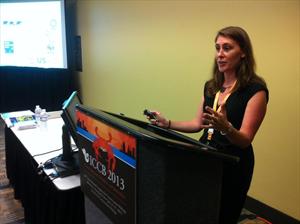ABCG Goes to the ICCB 2013 Symposia, Wednesday 24th July
ABCG joined scientists from around the world to share recent work in conservation research, practice and recommendations in the historic venue of Baltimore’s Inner Harbor. Our symposium showcased the work of ABCG and our members on critical approaches to land use planning, competing demands for resources, and collaborative conservation work.:
- Overlapping Land & Resource Rights in Africa
Gaia Larsen, Associate in the International Financial Flows and the Environment, [World Resources Institute] - Optimizing Tradeoffs in Woodland Ecosystems: Carbon, Conservation and Communities—A Case study from The Murchison-Semliki landscape
Dan Segan, Conservation Planner, [Wildlife Conservation Society] - Reconciling Economic Growth and Forest Protection in the Congo Basin: Managing land use in Central Africa
Kirsten Hund, Senior Mining Specialist, [The World Bank] - High Conservation Value Forest Assessments and Other Tools for Geographic Priority Setting
Rachel Neugarten, Manager of Conservation Priority Setting, [Conservation International] - Implementation of Land Policy for Improved Ecosystem Management and Land Tenure in East Africa
Lilian Pineta, Vice President of Conservation Science, [the Jane Goodall Institute] - Developing Broader Solutions for Conflicting Land Use: Lessons from ABCG Approaches
Natalie Bailey, Coordinator, Africa Biodiversity Collaborative Group
In summary…
ABCG’s session explored the many conservation approaches to land use planning and the impacts on communities and conservation of the scramble for resources in Africa.
In many parts of sub-Saharan Africa, various actors lay claim to land for multiple, overlapping purposes. The same area may hold oil or minerals that could provide income to the government and jobs for people, rare species of wildlife that require uninterrupted habitat for their survival, or may be valued as sacred forests by local communities. Competing claims to limited land and natural resources present numerous challenges to stakeholders including conservationists, local communities, governments and the private sector, and require innovative, interdisciplinary approaches to find solutions.
Collaboration between international conservation NGOs, governments, development partners and others is a beneficial approach as it brings together different strategies, points of view and resources to address emerging and high priority threats to biodiversity and development in Africa. Competing demand for land and natural resources is a common theme of many of our ongoing efforts. Successful approaches require multifaceted strategies that tie together systems (ecosystems, agricultural systems), disciplines (conservation planning, extractive industries, land tenure, development), and stakeholders (local people, governments and conservationists).
The following are abstracts from the presentations to accompany the linked slides. The talks covered three themes of:
- Land Use Planning for Conservation
- Climate Change
- Overexploitation of Natural Resources
Natalie Bailey, ABCG’s Coordinator, closed out the engaging session with a talk on the collaborative and cross-cutting nature of the key messages shared by our presenters.

The Africa Biodiversity Collaborative Group (ABCG) engages in various approaches to address emerging and high-priority conservation issues affecting biodiversity in Africa, many of which are represented by the previous presentations in this symposium. Our work is guided in part by the Dar Vision for the Future of Biodiversity in Africa, which foresees that “By 2025, environmental degradation and biodiversity loss in Africa have been significantly slowed, people and nature are adapting to climate change, and species and ecosystem services are providing a foundation for human welfare in a society committed to sustainable economic development and equitable sharing of natural resource benefits.”
The approaches shared in this symposium range from legal rights to scenario planning, sustainability frameworks and community leadership in land use planning. Tradeoffs are inherently a part of each approach. This final presentation will address the benefits and challenges of the above approaches and will preface a discussion on competing interests, development needs and preservation and protection of biodiversity.


Add a Comment